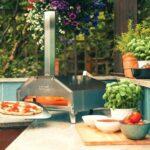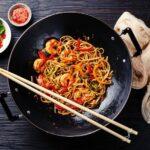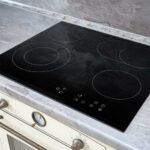If you have ever tried a Calphalon nonstick cooking pan then you know there is no going back. These pans are so premium and comfortable to use that they have become a chef’s favorite over the last few years.
As their popularity grew with time, more people started to use it. The problem is, we don’t know how to clean them properly. With nonstick pans, the cleaning process needs to be very specific. Otherwise, you run the risk of damaging the pan.
In this article, we will explore how to clean Calphalon pans or any hard-anodized pans for that matter.
You will find all the best methods and tricks we love to use every day in our kitchen. But first, let’s figure out what Calphalon pans really are and what makes them different.
What is a Calphalon Pan?
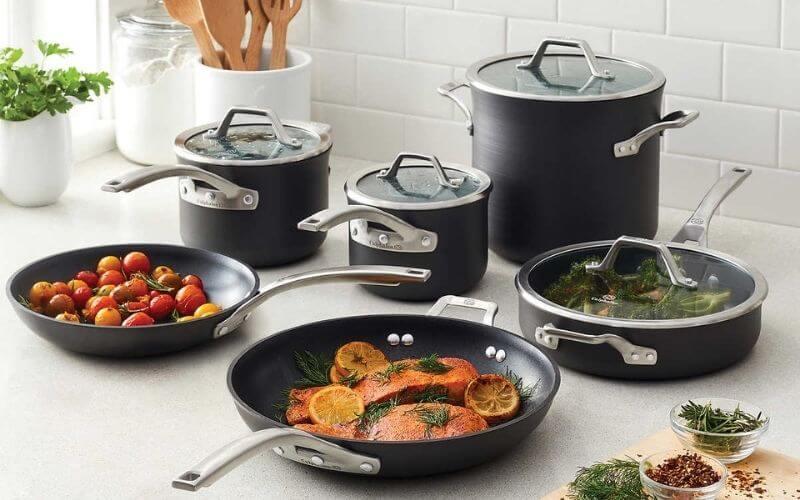
In simple words, Calphalon pan belongs to the category of cookware that is specifically named for cookware owned by a larger company “Newell Rubbermaid”.
It is famous for its non-stick surfaces, which are unique because they are made of anodized aluminum rather than Teflon, which is a much more common non-stick coating material.
Calphalon cookware has grown in popularity, and the appeal of a nonstick frying pan is particularly appealing to those who enjoy frying.
You might hear many of this type of cookware being referred to as “hard-anodization” cookware. What “hard-anodization” means is the electrochemical process the company uses to harden the aluminum used to make this type of cookware.
Calphalon’s aluminum becomes much tougher than ordinary aluminum thanks to the use of chemicals and electric pulses, allowing the material to be used for cooking.
This process also makes the cookware’s surface more resistant to abrasion and corrosion. A piece of this cookware that has undergone the hard-anodization process could theoretically be one of the most robust pans you can purchase.
Regular Cleaning for Hard Anodized Calphalon Pans
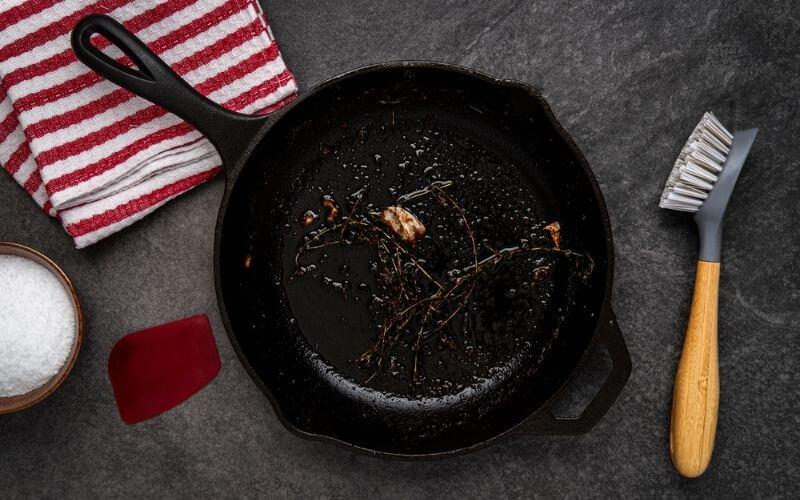
High-performance and nonstick cookware, the Calphalon pan can be a blessing in the kitchen, but after the meal has been eaten and leftovers are dealt with, it still needs to be washed.
Fortunately, Calphalon with its hard-anodized aluminum finish makes it a piece of cake to wipe clean even the most stubborn, stuck-on residue.
Things You’ll Need:
- Hot water
- Mild liquid dish soap and
- A soft sponge
- A soft-bristle dish brush
Instructions:
- Rinse the Calphalon pan with warm water: Hold the pan under the water stream and splash water around in it. Try to remove as much stuck-on food as possible, before you start scrubbing. Coldwater may cause the pan to warp or weaken if the temperature of the cooking surface is rapidly lowered.
- Wash the cooking surface of the pan by hand: Although some Calphalon cookware is technically safe for dishwashers, it is always preferable to wash non-stick surfaces by hand to preserve their tempered finish and luster. Hand cleaning will also allow you to spot clean the pan, giving it a more delicate treatment and increasing its durability.
- Use gentle soaps and scrubbers: Keep in mind to use soaps that don’t contain harsh chemicals or astringent agents. A mild liquid detergent like Dawn or Palmolive would work best. Soaps like these do not cause scratches. You should scrub your Calphalon pans with a non-abrasive sponge or soft-bristled dish brush.
- Rinse the clean pan thoroughly: After soaking and scrubbing your pan, be sure to wash away all the remains of food and soap. Otherwise, the remaining substances might dry on the cooking surface of the pan, creating an unhygienic film. Shake off the excess water and find a clean place to hang or layout the pan to start drying.
- Allow the pan to air-dry completely: Wipe your pan dry with a clean and dry absorbent towel. You can also keep the pan upside down on a clean counter or table and leave it to air dry. Remember to keep your pan in an open, well-ventilated area while it dries to quicken the process.
Follow these simple steps and your Calphalon pan will look brand new!
Deep Cleaning for Burnt Calphalon Pans
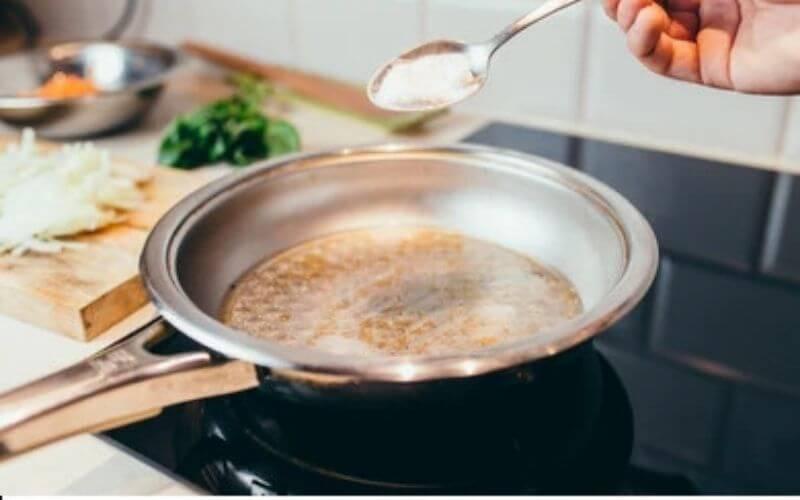
If your pan is crusted and dried due to getting burnt, it might take longer to clean the Calphalon pan. Still, the process is as easy as it can be. Simple traditional tools readily available in your kitchen should do the trick.
Things You’ll Need:
- Hot water
- A mild liquid dish soap
- Soft-bristle dish brush
- Baking soda
- White vinegar
- Salt and lemon
Instructions:
Baking Soda Method:
- Make a thin paste of baking soda and warm water.
- Apply 2-3 layers of the paste on the Calphalon pan cooking surface.
- Let it sit for a minimum of 30 minutes up to 1 hour.
- Scrub with a gentle-bristle dish brush.
- Later, gently wash the pan off under the tap.
Pro Tip: If the stain is dense, let the formula be on for a maximum time and apply another layer from time to time.
White Vinegar Method:
- Take equal proportions of white vinegar and water. Mix well.
- Put this solution in the burnt Calphalon pan and put the pan on the stove on low flame until it starts boiling.
- After 1-2 boiling waves, turn the flame off and let the solution rest in the pan for a couple more minutes.
- Remove the solution and scrub the burnt residues gently with a soft-bristled brush.
- Rinse well to clean the pan.
Salt and Lemon Method:
- Take 2 teaspoons of salt and 1.5 teaspoons of lemon juice (increase the quantity if needed).
- Apply the mixture to the area of burnt spots.
- Let it be there for a maximum of 30 to 45 minutes.
- Scrub with the soft-bristled brush without being too hard.
- Rinse well.
Key Tips for Cleaning Calphalon Pans
- Read the manufacturer’s recommendations for cleaning and caring for the particular piece of cookware you have bought.
- Protecting the temper of your nonstick cookware is key to extending its lifespan, so use gentle liquid soaps.
- For an extra soft touch, a simple cotton washcloth will also get the job done well
- Do not use steel wool, metallic brushes, and anything else likely to ruin the pan’s temper,
- Don’t keep away the pan wet with the lids on them, as this could lead them to smell.
- Store the Calphalon pan in a vertical dish rack to help it drain water while drying.
- Avoid high flames while treating a burnt pan to keep it safe in the long run.
Care and Maintenance Tips for Hard Anodized Pans

- Let the cooking surface cool down before washing.
- Always use warm or hot water to clean your Calphalon cookware.
- Whenever possible, use plastic utensils instead of metal ones to prevent scratches. Never attempt to cut ingredients while they’re inside the pan.
- Polish pots and pans with a special cleanser. If your pan starts to look dull after repeated use, products like Bar Keepers Friend or Calphalon Cookware Cleanser can restore the temper to its original condition.
Frequently Asked Questions
01. How Do You Get Stains Out of Calphalon Pans?
Calphalon pans are really sturdy and resistant so removing stains is not a big issue. If you happen to burn or stain the pan, using simple kitchen tricks like baking soda paste or vinegar solution can do the job.
Just take a tablespoon of baking soda and add a teaspoon of water to it. Create a paste and apply it all over the burnt, stained spots. Then leave the pan for 20 minutes. After that use a soft silicone scrubber and scrub the pan carefully.
You will notice all the stains have come off and it looks new again. Wash the pan under warm water and it’s good to go!
02. Do Calphalon Pans Wear Out?
No, not unless you use abrasive methods and dishwashers to clean it. The harsh detergent and liquid soaps and extremely high temperatures in the dishwasher can damage the tempered hard-anodized layers and wear the non-stick surface down.
The life expectancy of Calphalon pans are very high. Some say they last forever. But just like any other nonstick pans, if you see the upper layer chipping or peeling off, stop using it to make sure you don’t get any toxicity from it.
Calphalon however, provides a lifetime warranty for all its pots and pans. So if you don’t ruin them due to neglect. You should be able to get a replacement in case it starts to wear off. Pretty convenient, right?
03. What Can You Do With Old Calphalon Pans?
Recycling and reusing is often the best option for old Calphalon pans. Many users often go for redesigning and reusing their old pans into beautiful art pieces for the kitchen. But the recycling option is also an easy way out, as the manufacturer does it for you.
If you buy new nonstick pots and pans from Calphalon, a cookware company with a wide range of products, you can return your old nonstick pots and pans in the same box as your new purchases.
Calphalon provides a free main-in recycling system where you can send your old pots and pans. They then make sure that the pots and pans are recycled to their abilities. We think it’s quite environmentally friendly as well.
04. When Should You Throw Away Calphalon Pans?
Even though Calphalon claims their hard-anodized pans will last you a lifetime, no non-stick pan can be used forever. Non-stick pans are metal pans with a nonstick layer on top. The non-stick layer is made using many different chemicals.
When the tempered surface starts to chip away and appear warped, discolored, or scratched, stop using them.
If you accidentally eat those chipped non-stick layers, it can cause you several health issues and even cancer in rare cases. So never use chipped nonstick pans.
Usually, a high-quality non-stick pan like a Calphalon lasts around 5-6 years. Compare that to a standard non-stick pan which lasts around 10-12 months.
05. Are Calphalon Pans Worth the Money?
Calphalon was the first brand that introduced its customers to anodized aluminum cookware, which is popular because of the durability and strength of the products.
There actually aren’t many durable nonstick cookware brands out there. Most of them last for around 2-3 years whereas a single Calphalon pan can easily surpass 5 years of regular usage.
They feel and look premium and can retain a lot of temperatures while cooking. All these small details add up when you use a pan every single day.
The tempering process, durability, and long lifespan are just some reasons why it is worth the money.
06. Is Calphalon Toxic?
No. All the items produced by Calphalon are non-toxic cookware, with PTFE in its surfaces. If maintained well, the pans are non-toxic throughout their usage.
To Sum It Up
As promised, the solutions to such a brilliant kitchen appliance is as easy as it can be. With simple kitchen tricks, soft touch, and care, a Calphalon pan can be your best friend in the kitchen, giving you services for years to come.
Was it helpful? Do you have some tips of your own? Comment down below to let us know!


